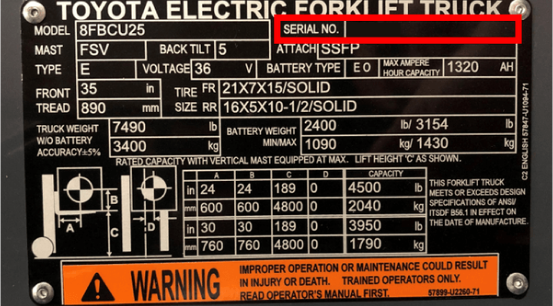How to Find Your Equipment Model Number
Finding the right parts for your equipment is easy when you have your model and serial number which can be found on the data plate. Luckily, a forklift data plate is installed on every truck on the market to help you understand what your forklift can do and provide vital information.
Model Number: The model number of your toyota forklift is extremely important for relaying information to your dealers about repair or technical assistance and for looking up replacements part!
Serial Number: The serial number on your lift is the most important number.The model serial number combination will allow us to provide you with the parts that will fit your particular piece of equipment.

How to Find Your Equipment Serial Number
Finding the right parts for your equipment is easy when you have your model and serial number which can be found on the data plate. Luckily, a forklift data plate is installed on every truck on the market to help you understand what your forklift can do and provide vital information.
Model Number: The model number of your toyota forklift is extremely important for relaying information to your dealers about repair or technical assistance and for looking up replacements part!
Serial Number: The serial number on your lift is the most important number.The model serial number combination will allow us to provide you with the parts that will fit your particular piece of equipment.

Need some help? For further assistance or more information, contact your local Toyota Dealer.

Please click below to sign in to your MyToyota account
Don't have an account?
Is Driving A Forklift Like Driving A Car?

If you’ve never driven a forklift before, it may seem exactly like driving a car. However, the four wheels and the seatbelt (in most cases) are where the similarities end. If you try to drive a forklift the same way you would a sedan, you’ll realize how different they are, and potentially cause a lot of damage and harm in the process.
Driving A Sit-Down Forklift
Forklifts use rear-wheel steering because the front wheels bear the load of whatever is being carried. Due to this feature, forklifts behave differently than modern sedans when it comes to turning or steering. You cannot take turns too quickly, as this action can put the forklift at risk of a tip-over or spilled load. Operators must also account for rear-end swing when turning, as the large and heavy counterweight swings out behind the forklift. Failure to account for this can cause damage to equipment and harm to pedestrians.
Forklift operators spend a great deal of time driving in reverse. Large loads on the forks can sometimes obscure operator vision, making it necessary to drive backwards for maximum visibility. When driving down a hill with a load, operators must often drive in reverse to keep loads from slipping off the forks and to maintain stability. Driving with the load down the slope could cause a tipover due to a change in weight distribution. Operators should be specifically trained for many situations, and should constantly monitor their surroundings for potential hazards or unaware pedestrians.
You may think you can drive a forklift because you can drive a car, but never attempt to operate heavy machinery without appropriate training and certification.